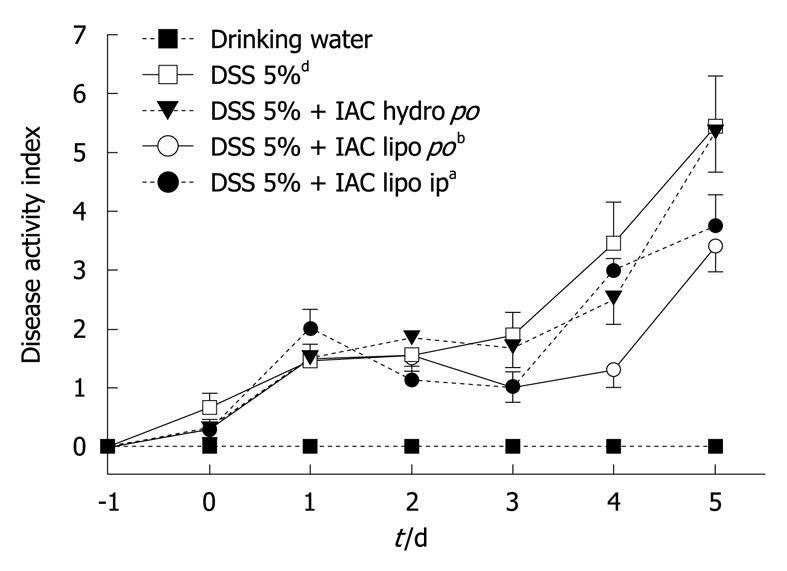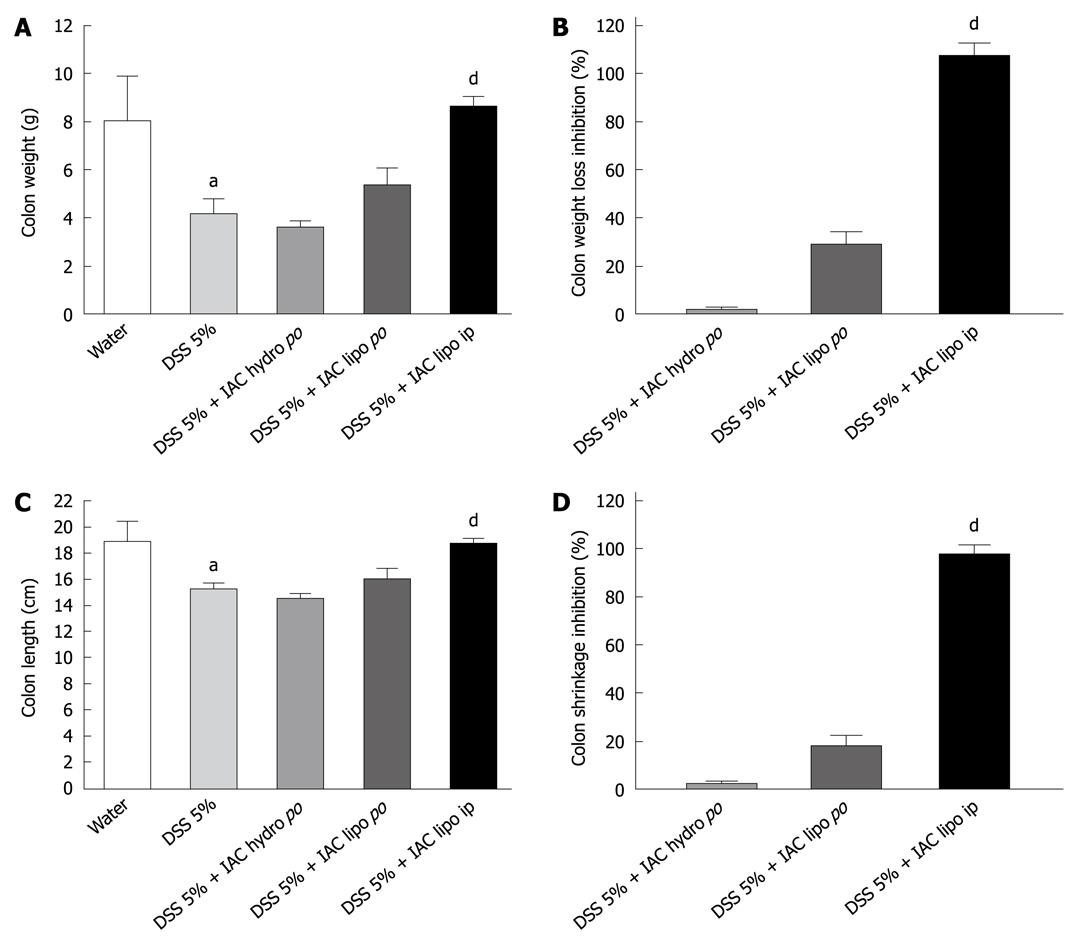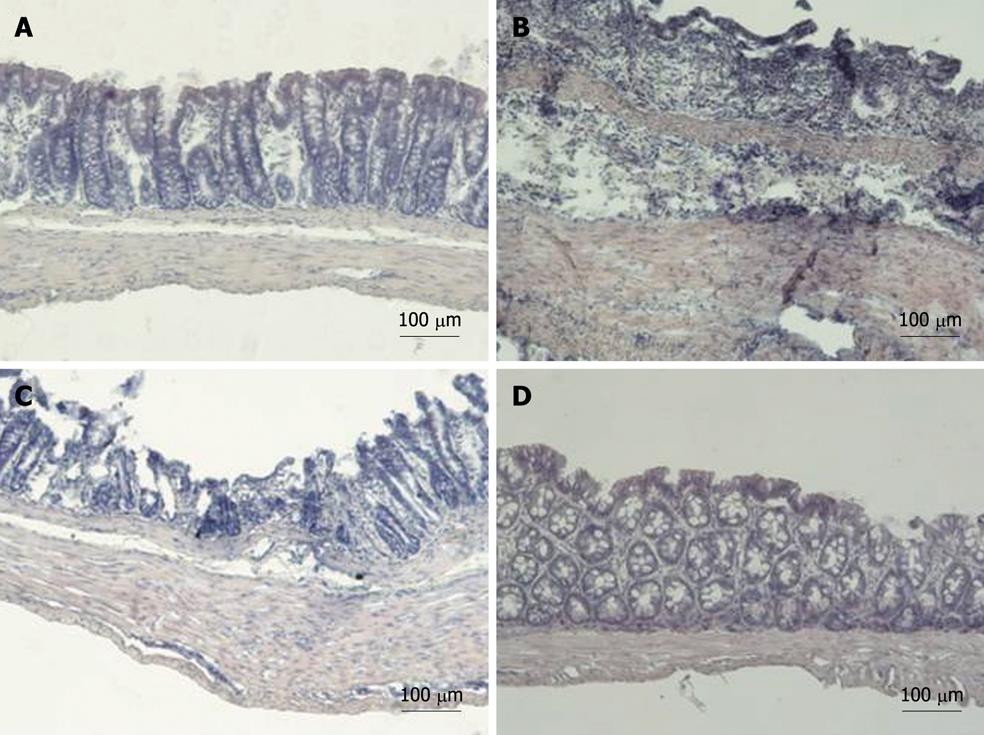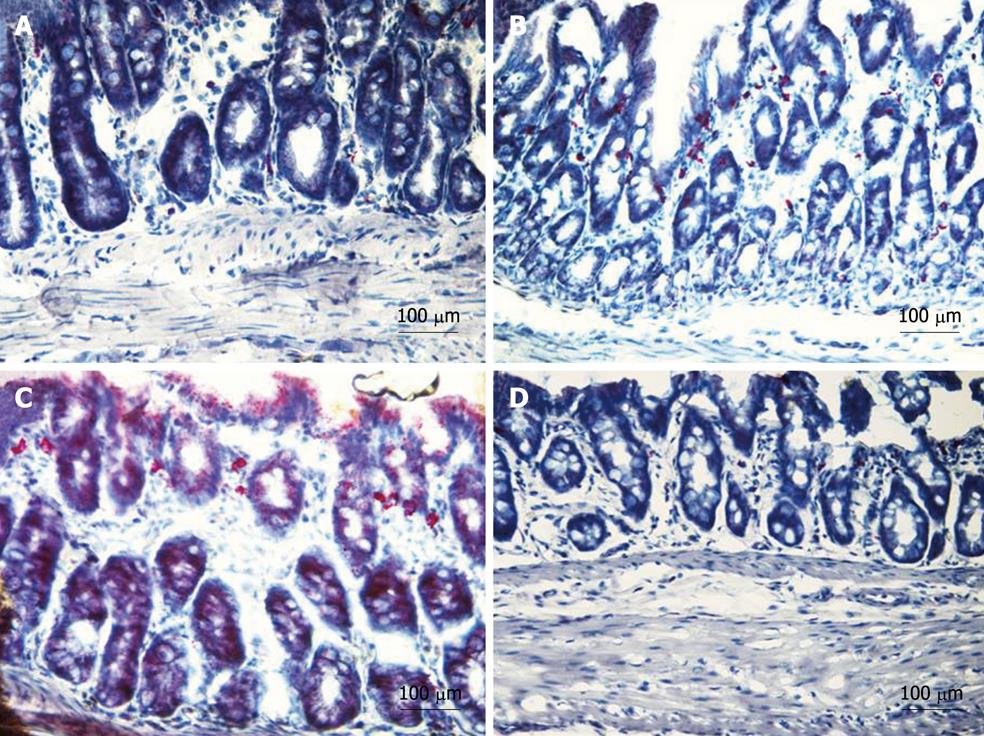Copyright
©2010 Baishideng.
World J Gastroenterol. Aug 7, 2010; 16(29): 3642-3650
Published online Aug 7, 2010. doi: 10.3748/wjg.v16.i29.3642
Published online Aug 7, 2010. doi: 10.3748/wjg.v16.i29.3642
Figure 1 Bis(1-hydroxy-2,2,6,6-tetramethyl-4-piperidinyl)decandioate structure.
Figure 2 Effect of bis(1-hydroxy-2,2,6,6-tetramethyl-4-piperidinyl)decandioate 30 mg/kg on disease activity index in the different experimental groups.
Data are expressed as mean ± SE; n = 5-12 rats per group. aP < 0.05, bP < 0.01 vs dextran sodium sulphate (DSS); dP < 0.001 vs drinking water. Bis(1-hydroxy-2,2,6,6-tetramethyl-4-piperidinyl)decandioate (IAC) hydro: Hydrophilic form of IAC; IAC lipo: Lipophilic form of IAC.
Figure 3 Effect of bis(1-hydroxy-2,2,6,6-tetramethyl-4-piperidinyl)decandioate 30 mg/kg (hydrophilic or lipophilic form) on total macroscopic (A) and microscopic damage score (B) and on myeloperoxidase activity (C) in the different experimental groups.
Treatment with hydrophilic bis(1-hydroxy-2,2,6,6-tetramethyl-4-piperidinyl)decandioate (IAC) po decreased colonic microscopic damage but had no effect on macroscopic and myeloperoxidase (MPO) activity. Six-day treatment with lipophilic IAC po and ip significantly reduced intestinal damage induced by inflammation. Data are expressed as mean ± SE; n = 5-12 rats per group. aP < 0.05, bP < 0.01 vs dextran sodium sulphate (DSS); dP < 0.001 vs drinking water. ICC hydro: Hydrophilic form of IAC; IAC lipo: Lipophilic form of IAC.
Figure 4 Effect of bis(1-hydroxy-2,2,6,6-tetramethyl-4-piperidinyl)decandioate 30 mg/kg (hydrophilic or lipophilic form) on dextran sodium sulphate-induced colon weight loss (absolute value, A, and % inhibition, B) and shrinkage (absolute values, C, and % inhibition, D) in the different experimental groups.
Six-day treatment with lipophilic bis(1-hydroxy-2,2,6,6-tetramethyl-4-piperidinyl)decandioate (IAC) ip significantly inhibited colon weight loss and colon shrinkage induced by inflammation, while the hydrophilic form had no effect. Data are expressed as mean ± SE; n = 5-12 rats per group. aP < 0.05 vs water; dP < 0.01 vs dextran sodium sulphate (DSS). IAC hydro: Hydrophilic form of IAC; IAC lipo: Lipophilic form of IAC.
Figure 5 Representative examples of cross sections of distal colon.
A: From a non-inflamed rat [drinking water + bis(1-hydroxy-2,2,6,6-tetramethyl-4-piperidinyl)decandioate (IAC) vehicle orally]; B: From an inflamed rat [dextran sodium sulphate (DSS) 5% in drinking water + IAC vehicle orally]. Note the dramatic loss of mucosal architecture with crypt dropout and the granulocyte infiltrate extending throughout the mucosa and submucosa; C, D: Cross sections of distal colon from an inflamed rat treated with hydrophilic (C) and lipophilic (D) IAC 30 mg/kg orally (C) and intraperitoneally (D). Lipophilic (po, not shown here, and ip) IAC 30 mg/kg decreased the microscopic damage produced by DSS, facilitating mucosal healing, reducing inflammatory cells infiltration and muscle thickening (panel D). Hydrophilic IAC po failed to protect the colon from the damage induced by DSS (panel C).
Figure 6 Naphthol AS-D chloroacetate esterase positivity (red) in cross section of distal colon.
A: Tissue sections obtained from non-inflamed rats showed occasional red staining indicating a low presence of neutrophils within the bowel wall under physiological conditions; B: From a rat with colitis (5% dextran sodium sulphate in drinking water, panel B). Compared to non-inflamed rats, tissue from rats with colitis showed a massive neutrophil infiltration extending throughout the mucosa (note the scattered degranulation within the crypts and submucosa); C, D: Treatment with bis(1-hydroxy-2,2,6,6-tetramethyl-4-piperidinyl)decandioate (IAC) 30 mg/kg hydrophilic form po (C) was unable to suppress neutrophil infiltration especially in the mucosa. Treatment with lipophilic IAC both po (not shown) and ip (D) almost completely suppressed neutrophil infiltration within the colonic wall.
- Citation: Vasina V, Broccoli M, Ursino MG, Canistro D, Valgimigli L, Soleti A, Paolini M, Ponti FD. Non-peptidyl low molecular weight radical scavenger IAC attenuates DSS-induced colitis in rats. World J Gastroenterol 2010; 16(29): 3642-3650
- URL: https://www.wjgnet.com/1007-9327/full/v16/i29/3642.htm
- DOI: https://dx.doi.org/10.3748/wjg.v16.i29.3642














